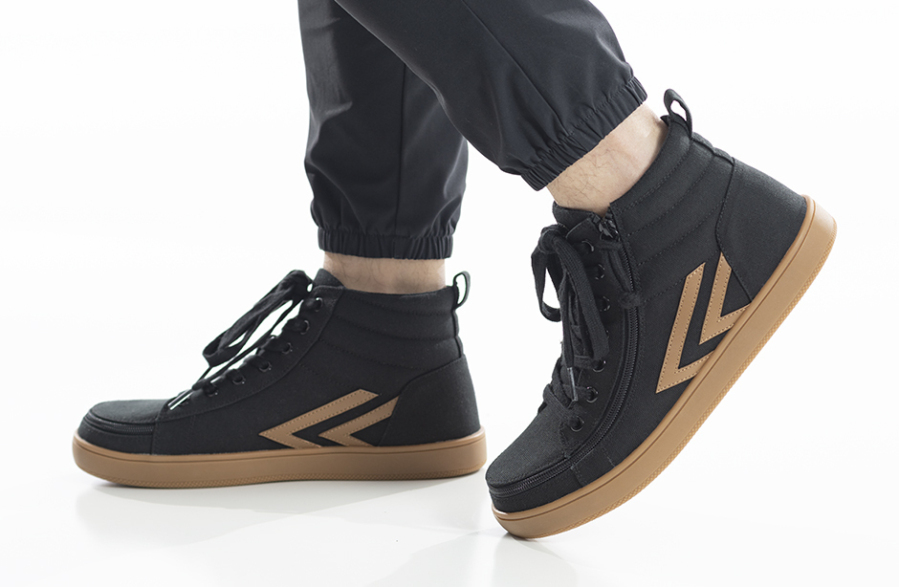NEW YORK — Mindy Scheier was working in fashion before her son, Oliver, was born with muscular dystrophy. As he grew, and she watched him struggle to get dressed, her eyes were opened to her industry’s limitations for people with disabilities.
At 8, Oliver wanted to ditch his sweatpants for jeans. His mom couldn’t find any to accommodate his leg braces and difficulty working zippers and buttons, so she began making adaptations herself.
She put strips of fabric fastener on the inseams of the jeans, and she replaced the button and zipper on the front with the same.
Now, Scheier dedicates herself to raising awareness about the need for designers and retailers to embrace adaptive clothing through her Runway of Dreams Foundation and Gamut Management talent and consulting agency.
Scheier has brought on board some of the largest U.S. brands and retailers. While adaptive clothes, shoes and other gear have made strides in the last few years, more is needed, she said.
“What we learned was brands were so afraid to get into the space for fear of doing it wrong, saying something wrong, not knowing where to start,” she said. “We work with brands to guide them through the process.”
Oliver, now 18, is pleased with the progress, but he said melding fashion with functionality for his age group has lagged behind offerings for younger kids and adults.
“It’s all about opportunity and the chance for people like me and people my age to express themselves through fashion like any able-bodied person,” he said. “It says a lot about who I am on the inside, and adaptive clothing allows me to do that.”
It’s also about including people with disabilities in the design process, taking care to offer such things as hidden openings for medical ports, tubing and bags, or less bulk in the front and a higher rise in the back of pants for wheelchair users. Dressing without help is made easier with things like pull-on loops at the sides of skirts and pants, and wider necks on pullover shirts.
Shoes must be wide and sturdy enough on the inside to accommodate braces or prosthetics. Zippers or other fasteners make them easier to put on for people without full use of their hands.
Adidas was among the giants to work with Scheier. The company consulted Oliver and others with disabilities on an adaptive backpack that has a flat bottom, wider loops on zippers, and straps that can easily attach to wheelchairs and scooters.
From Tommy Hilfiger to Target, brands and niche online sellers such as No Limbits and Billy Footwear are serving people with disabilities. JC Penney, Walmart, Kohl’s, Amazon, Uggs and Zappos also offer adaptive fare.
Walmart is among the newest entrants, partnering with brands that specialize in adaptive. The company is working to include more styles for older kids.
“Tweens are, in my opinion, an underserved customer holistically today,” said Brandy Lackey, a Walmart senior director of product development who worked on the recent rollout.
The adaptions required are as diverse as the people in need, including those with sensory processing issues who require softer fabrics, no tags and no-itch flat seams.
Niche sellers are also seeing the need. A company called French Toast, for example, sells a crisp white Oxford shirt with fabric fasteners hidden behind a line of buttons for young people required to wear school uniforms.
Billy Footwear was co-founded by Billy Price, a wheelchair user who broke his back at age 18 and had trouble putting on shoes by himself. His company offers a slew of trendy footwear with a zipper that goes down one side and around the toe, opening the entire top.
“Our goal was to be able to come out into the market with an easy shoe that could work for anybody,” he said.
Working for everybody is important to Price, Scheier and others who support a universal approach that means adaptations are built into garments and other gear that also appeal to the able-bodied.
In its eighth year, Billy Footwear did about $10 million in sales last year, with customers split evenly between those who require accommodations and those who don’t.
With more than 60 million adults and more than 3 million children living with disabilities in the U.S., Oliver sees a win-win for companies.
“We want to wear this stuff but we can’t,” he said. “There’s a financial opportunity there.”
Open Style Lab, a nonprofit committed to making style accessible for everyone, is also engaged. It offers a 10-week program bringing together occupational therapists, people with disabilities, engineers and designers to co-create functional and stylish clothing and accessories, said Yasmin Keats, the executive director.
“We want to educate the next generation of designers on how to do inclusive design better,” she said.
Erica Cole, 27, lost a leg in a 2018 car crash when she was 22. She found that offerings for pants to accommodate her prosthetic fell far short of fashion.
“The socket was so large on my first prosthetic. My calf was more of the size of my thigh. So I was wearing sweat pants that were three sizes too large and shorts in the middle of winter because I couldn’t get anything to fit over the top of it,” she said. “So I started altering clothes for myself.”
She turned her solution into No Limbits. It offers hipster jeans and other pants with side zippers, less bulk at the front and stretchy waist bands for wheelchair and prosthetics users. She included front thigh pockets for easy access while seated.
Older kids, she agreed, remain underserved. No Limbits hopes to rectify that in future drops.
“We’ve been talking to a lot of parents and there’s a lot of anxiety around kids aging out of the kids sizes in adaptive clothing. Suddenly they’re in the junior section and there’s nothing. That’s still where the gap is,” Cole said.



